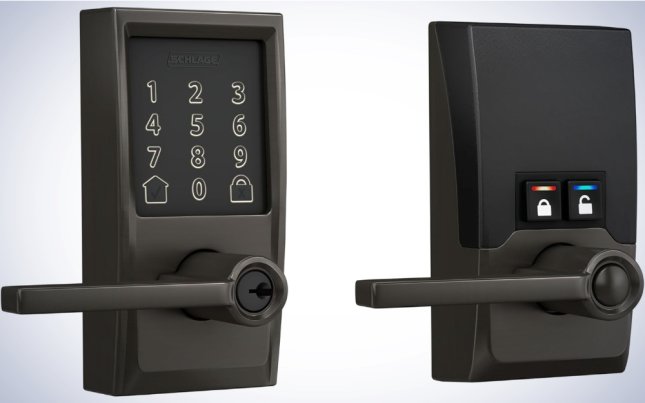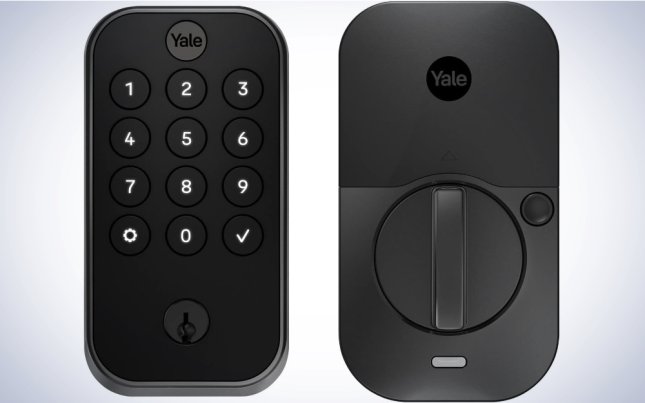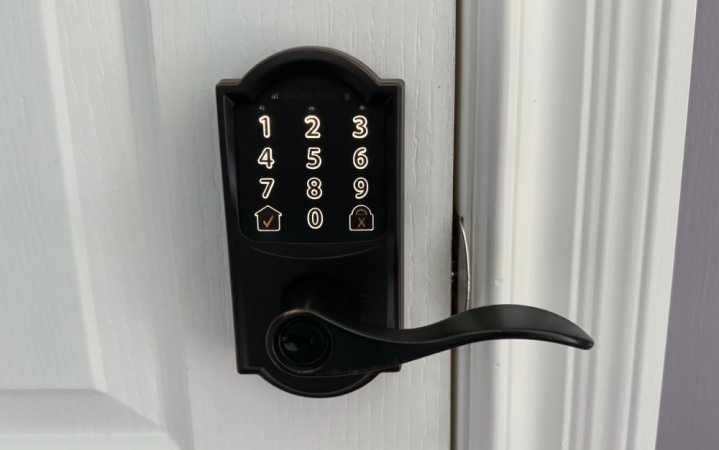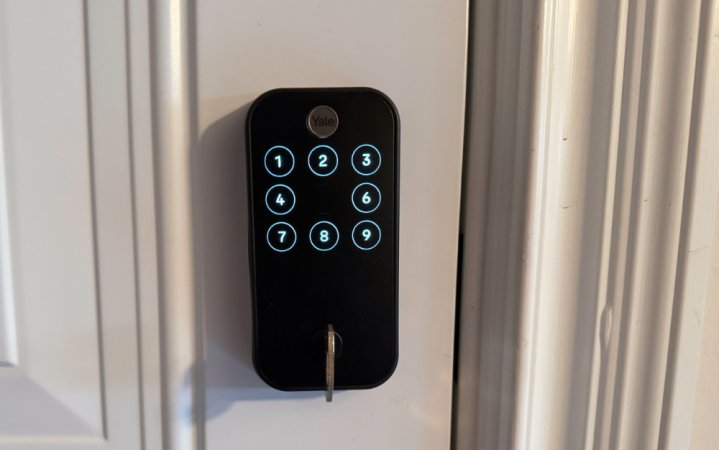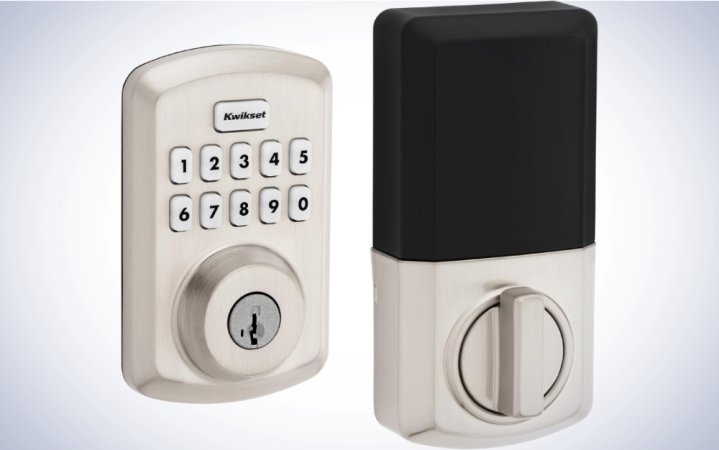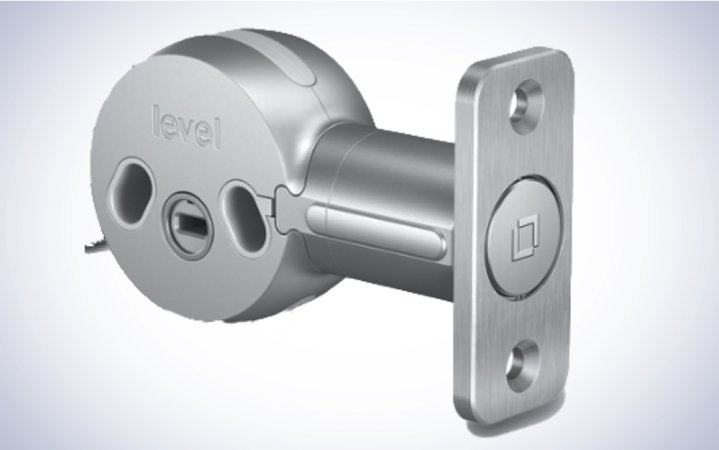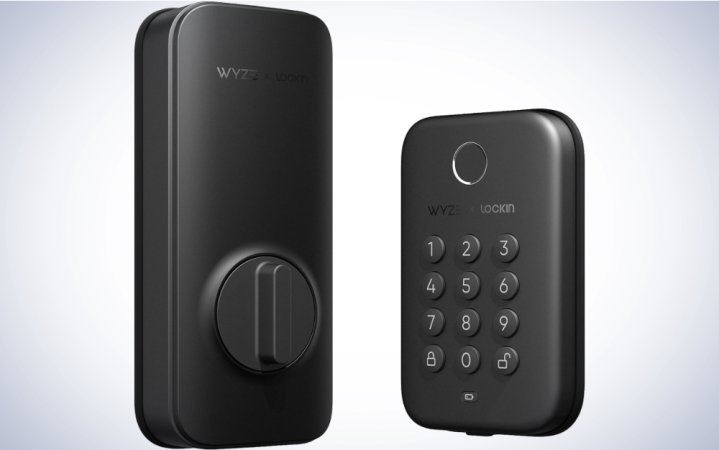We may earn revenue from the products available on this page and participate in affiliate programs. Learn more ›

Keypad door locks, once popular in commercial settings, have quickly gained traction with homeowners in recent years. The devices add convenience by eliminating the need to fumble with keys to get inside and allowing homeowners to grant access to friends and family by programming temporary passcodes. The best locks can also make your home more secure. Some, for example, automatically lock the door when you or a family member forgets to flip the bolt. For even greater control, smart keypad door locks allow you to remotely lock and unlock the door, program passcodes, and even track who’s coming and going. With so many options available, it can be difficult to find the right one. This guide will review the factors you should consider when shopping for the best keypad door locks.
- Best overall: Schlage Encode Century Wi-Fi Latitude Lever
- Best Wi-Fi: Yale Assure Lock 2 Touch with Wi-Fi
- Best electronic deadbolt: Kwikset Powerbolt 250
- Best without a keypad: Level Bolt
- Best budget: Wyze Auto-Lock Bolt
How we chose the best keypad door locks
We assessed dozens of keypad door lock options, considering various factors. We considered installation to determine how easily the average DIYer could set up the lock. We also evaluated how easy it was to program (and delete) codes and how many different codes the lock supported.
A good keypad door lock shouldn’t require an IT pro to get it online and running, so we looked at how compatible the device was with smart devices, smart home systems, and home automation platforms—as well as ease of setup. Your lock should integrated as easily into your smart security system as wired or indoor cameras. Since all keypad door locks use a battery, we considered battery life as well; these devices are supposed to add convenience, not create more work by constantly requiring battery changes.
The best keypad door locks: Reviews & Recommendations
Why a keypad door lock? We asked Erik Glassen, senior manager of brand marketing at Spectrum Brands, just that.
“The primary benefit of a keypad lock is not needing to carry around keys, which can be lost or stolen. It makes it convenient whether you are out for a jog or you have kids who no longer need to keep track of house keys,” Glassen says. “You can also give access to housekeepers or temporary guests without having to give out a key, which may or not get returned.” One of our picks should help you make the switch to the keyless lifestyle.
Best overall: Schlage Encode Century Wi-Fi Latitude Lever
Best Electronic
First Impression
Pros
- Simple installation
- Out-of-the-box Wi-Fi compatibility
- Doesn’t require a deadbolt to install
Cons
- Not a deadbolt replacement.
Why it made the cut: Schlage’s smart keypad door lock was easy to install, connected to our home network, and had multiple forms of entry.
Specs
- Wi-Fi connectivity: Yes
- Dimensions: 3 x 5.88 inches
- Battery: 4 AA batteries
Most keypad door locks are designed to replace a deadbolt, but the technology in Schlage’s Latitude Lever is built into its handle. This allows you to install it on doors inside your home or on an outside-facing door with a lever door handle. Installing this smart door lock took about a half-hour (and a screwdriver), thanks to the included instructions. This includes the time it took to remove our existing door handle. While this would qualify as a home DIY project, we can recommend it to folks who consider themselves less handy, as you won’t have to cut any new holes or deal with any significant wiring during your installation.
Once installed, we were prompted to download the Schlage Home app (available on iOS and Android) to set up its wireless functions. It took another 15 minutes or so to pair the lock with our smartphone, connect it to our home’s Wi-Fi router, and download a new firmware update. We were pleased that Schlage took the time to design an app that’s both functional and easy to understand. From its main screen, you’re able to see the current status of the Latitude Lever, which you can change by tapping on the giant picture of a lock, and its battery life. Buttons at the bottom of the screen take you to sections of the app where you can monitor when it was last locked and unlocked and by whom.
Schlage allows you to create up to 100 entry codes—which you can delete at any time—and asks whether you’d like to receive a notification when each code was used. This can be helpful as you’re probably not interested in getting pinged each time someone you’re living with comes inside. You can still review who’s used the lock at any time by hitting the “History” button on the Schlage Home main screen. If you or someone you live with are uninterested in smart features or a keypad, you can always give them the physical key Schlage includes with the Latitude Lever. That said, the Latitude Lever is best used as a keyless entry door lock and can even be managed using Amazon’s Alexa or Google Assistant.
Overall, we were pleased with how easy it was to set up and manage Schlage’s Latitude lever and just as happy with how well it worked. We could reliably lock and unlock this keypad door lock from inside and out of our home and never had an issue with a network disturbance or other anomaly. It gave us peace of mind to know exactly when the door was locked and unlocked and by whom. This information is handy to have whether the Latitude Lever is installed on the interior or exterior of your home. If you want this same functionality in a smart deadbolt, Schlage has you covered with the Encode Smart Deadbolt.
Best Wi-Fi: Yale Assure Lock 2 Touch with Wi-Fi
Best WiFi
Wireless Wonder
Pros
- Easy installation
- Touch-sensitive buttons
- Fingerprint reader
Cons
- App has a learning curve
Why it made the cut: Yale’s Assure Lock 2 was easy to install, maintained a rock-solid connection to our Wi-Fi network, and looked unassuming from the outside.
Specs
- Wi-Fi Connectivity: Yes
- Dimensions: 2.5 x 3.75 inches
- Battery: 4 AA batteries
If remote monitoring is a must-have keypad door lock feature, your best bet is Yale’s Assure Lock 2 Touch with Wi-Fi. The keypad door lock replaces an existing deadbolt in your home and allows you to lock or unlock it using the Yale Access app (on iOS or Android), a keypad code, fingerprint, Amazon’s Alexa, Google Assistant, or key. It only took about a half-hour to disassemble our previous deadbolt and install the Assure Lock 2.
Yale’s directions were clear, and the entire installation only required a screwdriver. It’s important to note that you’ll have to pop in a standalone Wi-Fi module inside the keypad door lock (it’s included and fits snugly into a slot) to enable all its wireless functionality. Once it was set up, we headed over to the Yale Access app to configure the lock. Connecting smart home accessories to a home network can sometimes be a pain, but the Assure Lock 2 connected to our Wi-Fi network the first time. After downloading and installing a firmware update, we could finally fully configure the keypad door lock.
The Yale Access app’s home screen shows the lock’s current status (you can lock and unlock it by tapping on the circle in the middle of the screen), as well as its current Wi-Fi status. You can access other parts of the app by tapping on glyphs at the bottom of the screen, but they don’t have any text above them, so it’ll take a couple of days to be able to successfully get to the settings you want without a second thought. That said, you can access your lock’s activity (a history of when it was locked and unlocked), manage your guest list, and access a more robust settings menu in just a tap. We were pleased with how granular you can get when inviting or managing the Assure Lock 2’s guest list. You can adjust their access level by assigning them an entry code, fingerprint, or full app access. If someone you know doesn’t want to opt into the smart home lifestyle, a physical key is bundled with the Assure Lock 2.
Trusting something as important as access to your home with a gadget can seem intimidating, but we’ve had no issues with the Assure Lock 2 in the weeks since it was installed. We could always access, lock, and unlock it using our phone, key, fingerprint, or code. Its connection to our network was absolute and never cut out for any reason. Be sure to immediately check the network status of your Assure Lock 2 upon installation if your Wi-Fi router is located far away from the door (you may need to consider a mesh network with the latest Wi-Fi protocols). If you need a keypad door lock that can be controlled from anywhere, Yale’s Assure Lock 2 is an excellent choice.
Best electronic deadbolt: Kwikset Powerbolt 250
Best Electronic Deadbolt
Bolt Action
Pros
- Auto-locking mechanism
- Backlit keys
- Keypad can be disabled
Cons
- No smart features
Why it made the cut: Kwikset’s keypad door lock can’t be controlled remotely, but it’s still an excellent choice for those not sold on a smart home.
Specs
- Wi-Fi Connectivity: No
- Dimensions: 2.69 x 4.59 inches
- Battery: 4 AA batteries
If you’re interested in living the keyless entry door lock lifestyle but don’t want to worry about smart features, Kwikset’s Powerbolt 250 is the one to get. The electric deadbolt only requires a screwdriver to install, and it 10-button keypad allows you to create customizable codes that crooks can’t crack, all without the use of a smartphone app. Kwikset says you can make up to 25 permanent user codes and five single-use codes with this model.
You can add codes by pushing a “program” button located inside the keyless door lock’s battery compartment. Once pressed, you must press the “1” button on the door lock keypad, followed by the “Kwikset” button, followed by the four- to eight-digit passcode, followed by the “Kwikset” button. Once you’ve completed that sequence, the code has been permanently saved. It may seem tedious, but adding a code should only take you about a minute.
The Powerbolt 250 may not be smart in the modern sense, but it has some useful design features beyond the ability to program two dozen codes. It can be set to automatically lock after a set period of time (up to 10 minutes), has backlit keys that illuminate when you press keys on its keypad, and has a “Vacation Mode” that disables the keypad entirely for a set period of time. When in vacation mode, you’ll only be able to unlock the Powerbolt 250 with the included key.
It’s very useful to have all of these smart features available in an electric deadbolt that doesn’t require an app to set up and manage. You won’t get advanced features like remote monitoring, but Kwikset’s Powerbolt 250 is still an excellent choice.
Best without a keypad: Level Bolt
Best Without a Keypad
Easy Install
Pros
- Supports every major smart platform
- No keypad to worry about
- Works with your existing keys
Cons
- Price
Why it made the cut: Level’s Bolt is the smart upgrade to your existing home security system that you’ve been waiting for.
Specs
- Wi-Fi connectivity: Yes
- Dimensions: 3.31 x 1 inches
- Battery: CR2 battery
If you’d like to install a smart lock without a keypad, you’ll want to use the Level Bolt. The Bolt replaces your existing deadbolt and allows you to unlock your door using your existing keys, the Level Home app on iOS and Android, Amazon’s Alexa, or Google Assistant. Level says you’ll be able to install the Bolt with just a screwdriver and that it was designed to fit in standard door frames. The Bolt comes with two components: A deadbolt, which will replace the one on your door, and a bridge (wireless receiver) that needs to be plugged into an outlet. The bridge will connect your Level Bolt to your home’s Wi-Fi network, allowing you to lock and unlock it remotely.
Once it’s configured, you can use the Level Home app to see when the Bolt was locked and unlocked and create new virtual keys for different people. A big benefit of the Level Bolt is its simplicity. You’re only replacing one part of your door’s locking mechanism, which is why you’ll still be able to use the same keys. If you’re waffling on the idea of getting a smart lock without a keypad, Level offers a Smart Keypad accessory, so you’ll have the ability to add one to your system later on. The Level Bolt is among the most expensive keypad door locks we’re recommending, but it’s a great option if you’d like to expand your smart home without inconveniencing the people you live with.
Best budget: Wyze Auto-Lock Bolt
Best budget
Easy Access For People That Need It
Pros
- Wireless connectivity over Bluetooth
- IPX5 water resistant
- Price
Cons
- No Wi-Fi
Why it made the cut: Wyze’s durable auto-locking smart keypad lock is impossible to beat for its price.
Specs
- Wi-Fi Connectivity: No
- Dimensions: 6.8 x 3 inches
- Battery: 4 AA
If you’re interested in a keyless entry door lock with three means of entry, water resistance, and a $70 price tag, it’s impossible to beat Wyze’s Auto-Lock Bolt. The keyless door lock allows you to enter your home using an iOS and Android app, a pre-programmed code, or your fingerprint. Wyze says replacing your existing deadbolt should only take about 20 minutes and a screwdriver. Once you’ve installed the Auto-Lock Bolt and Wyze’s app, you can pair the smart device to your smartphone using Bluetooth. The Auto-Lock Bolt does not support Wi-Fi, so you won’t be able to monitor or control it remotely. You can see when your lock was unlocked (and by whom) when you’re home or return to your place.
You can use Wyze’s app to save up to 16 codes and 50 fingerprints. Wyze says the Auto-Lock Bolt can register a fingerprint in under half a second. You can set certain codes and fingerprints to only register on a certain schedule, which is helpful if you’ve got guests coming for a weekend, or have a babysitter, tutor, or tradesperson who needs limited access to your home. You can also lock or unlock your door using Amazon’s Alexa. If Wi-Fi functionality isn’t important in choosing your keypad door lock, the Wyze Auto-Lock Bolt is the best value in its category. If remote unlocking is a must-have feature, you can step up to the Wyze Lock, which adds this functionality (and more), but costs over twice as much.
What to consider before buying the best keypad door locks
The digital door lock industry is large and is only expected to get bigger over the years. That means there are a lot of options on the market—with all those options, you’ll need to know what to look out for.
“The features consumers typically look for are multiple user codes (for homeowners and guests), one-touch locking, vacation mode (keypad can be disabled when you are away), [and] backlit keypads (for nighttime or dark locations),” says Erik Glassen, senior manager of brand marketing at Spectrum Brands. “Other features are security grade [BHMA [grades] 1, 2, or 3], easy installation, and a backup keyway in case batteries are low,” says Glassen at Spectrum Brands.
Here are other helpful features you should look for in your search:
Connectivity
More and more keypad door locks have smart capability, meaning they can connect to Wi-Fi or a smart-home hub. Smart keypads give you greater control over the lock, allowing you to lock and unlock the locks remotely, add and remove user codes, access user logs, and even set when codes are and aren’t active.
Battery life
Most but not all keypad door locks run off of batteries. Battery life depends on the keypad lock as well as how often it is used. When shopping for a keypad door lock, consider where it will be used and how often, then check the model’s estimated battery life to determine if it’s right for the job. Many electronic keyless locks will run for between 3 and 5 years on one set of batteries, while others may last less than a year. While features such as auto-locking are nice to have, they do put more of a strain on the batteries.
Extra security features
While some keypads offer a basic setup that allows you to open a lock with a code, others offer features to enhance protection. This includes automatic locking, which flips the lock after about 30 seconds to ensure that you or a family member doesn’t accidentally leave a door unlocked. Some door locks will also disable the keypad after a set number of failed attempts or even set off an alarm to scare away would-be intruders.
Keypad vs. touchscreen lock
Nowadays, everything operates via a touch screen. But, per Glassen, you might be better off sticking with a keypad lock.
“The benefits of a keypad lock versus a touchscreen lock are that [keypad locks] are typically less expensive,” Glassen says. “They are generally more durable and perform better in extreme weather (cold or direct sunlight). They don’t show fingerprints or smudges and can be operated with a glove/mitten on the hand. With a touchscreen, skin contact is typically needed.”
Additionally, if working with a Wi-Fi-operated lock, make sure there’s a power backup available or an option to use your keys in case of emergency. You don’t want to be left outside in a storm because the power is out, and it took the Wi-Fi with it.
FAQs
The cost of a keypad lock can vary significantly. Basic battery-powered keypad deadbolt locks run around $50, while high-end smart locks may cost as much as $300. This price difference is because smart deadbolts have built-in wireless connectivity. Mid-tier models include keypad door locks with handles, which run for about $100.
Most but not all keypad locks use batteries. Keypad locks that automatically turn the bolt when the correct code is entered and smart keypad locks both require batteries. Manual keypad locks that require you to manually turn the bolt after entering the correct code require no power source, but we’re not recommending any of those.
Keypad locks are no more or less safe than a standard lock. Since keypad locks have backup keys as a failsafe, both a keypad lock and standard lock can be picked. If you choose a model that connects to your home Wi-Fi, be sure your network is private and secure.
Traditionally, the main disadvantage of using a keypad door lock was that you’d need to memorize a code to enter your home. This has been mitigated in the era of smart locks because they give you the option to lock and unlock your door using an app on your phone. Many of our recommendations also feature a fingerprint reader, and some even let you use a key.
Yes. Keypad door locks can be programmed to lock themselves after a set period of time automatically.
No. Our hands-on tests found that a keypad door lock can be installed in roughly half an hour with a single tool and little DIY experience.
You should expect to get about a decade or so of use out of a smart keypad door lock, at which point it may not be supported by the software developed by the hardware manufacturer. If you use a less technically advanced model that can be programmed on its own, you should never have to replace your keypad door lock.
Final thoughts on the best keypad door locks
- Best overall: Schlage Encode Century Wi-Fi Latitude Lever
- Best Wi-Fi: Yale Assure Lock 2 Touch with Wi-Fi
- Best electronic deadbolt: Kwikset Powerbolt 250
- Best without a keypad: Level Bolt
- Best budget: Wyze Auto-Lock Bolt
If you’re looking to upgrade the locks on your front door, it’s tough to beat the quality and functionality the Schlage Camelot Keypad Deadbolt offers. It gives you added control with the ability to program numerous passcodes while also including a useful Flex Lock feature that helps ensure your door is locked when it should be. If your budget allows you to make the leap to a smart keypad door lock, Schlage’s Encode Deadbolt Smart Lock is easy to set up and is supported by a robust app that gives you refined control over access to your home.
